(1929-to date)
(Owens-Illinois, Inc. ~ since 1965)
This corporation is now generally known simply as “O-I”.
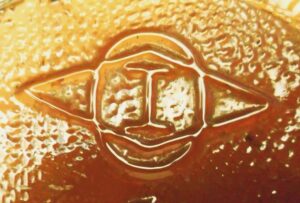
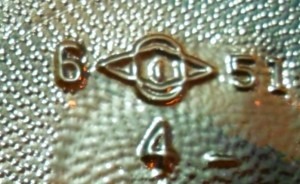
Owens-Illinois Glass Company was the result of the 1929 merger between two glass-making giants of the industry: Owens Bottle Company (Toledo, OH – predecessor Toledo Glass Company began operation in 1896) and Illinois Glass Company (based in Alton, Illinois, with glass production dating from 1873). See this page on Illinois Glass Company’s “I in a diamond” trademark.
Formerly headquartered at Toledo, OH; now based at Perrysburg, OH, Owens-Illinois, Inc. had (and has) many glass manufacturing locations worldwide. (See list of 20 currently operating glass container plants in North America, farther down on this page).
Known as Owens-Illinois, Inc. since 1965, (and officially known as just “O-I” since 2005), this corporation is currently (2024) the largest manufacturer of glass containers in the world.



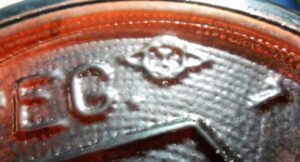
“Diamond and oval with I inside” trademark
Several trademarks have been used over the years by Owens-Illinois. Shown on this page are pictures of typical trademark variations used on glass containers, especially during the early years. Most of the pics show the first and most widely recognized mark used, beginning in 1929.
As pictured, it can vary slightly from one container to another. This mark consists of a “Diamond and O (oval) entwined, with an I in the center” and dates from 1929 into the middle and late 1950s. (Latest confirmed date code with this older trademark embossed on a bottle is 1966). The mark may not have been, in actual practice, engraved onto all their bottle molds (in their inventory or being used at that time) until sometime in the year 1930, simply because of the time and effort involved in re-tooling/altering large numbers of molds already in use. The mark is sometimes misinterpreted as the representation of an “eye” or of the planet Saturn.
Although author and researcher Julian Toulouse, in his ground-breaking reference work “Bottle Makers and their Marks” (published in 1971) promoted the idea that the diamond and oval trademark was used only up to 1954, implying a neat, clean “cut-off date”, in actual practice many bottles with this mark have been found that date several years after 1954. (More info, below, in the paragraph on the “I inside an O” trademark).
On very small bottles, the mark may be rather indistinct and the “I” may be virtually invisible, or just a tiny dot. It may be misinterpreted as the number “1”.
On the typical bottle, there is usually a number to the left of, to the right of, and below, the trademark. (Note: The above arrangement is the most commonly seen, at least on soda bottles, but some containers, such as liquor flasks, are frequently marked in other ways and thus the codes may be arranged in a different configuration. See the paragraph on this page below, titled “Liquor Bottle Permit Numbers”).
ADVERTISEMENT
PLANT LOCATION CODE NUMBERS
Typically, the number on the LEFT of the diamond logo is the plant (factory) location code number, the number on the RIGHT is a year date code, and the number below the logo (if present) indicates the mold number (mold identifying number, “mold cavity number” or serial number). NOTE: this arrangement generally applies to Non-Liquor bottles. On many liquor bottles made by Owens-Illinois, the number on the left is a Liquor Bottle Permit Number, not a plant location code. Please see the paragraph farther down on this page for more info on this subject).
For example, plant location code #2 stood for the Huntington, WV plant; “3″ indicated the Fairmont, West Virginia plant (that number was used up to 1981, later “3” was used by Muskogee, Oklahoma); “4” was Clarksburg, West Virginia; “7″ indicated Alton, Illinois; “9″, the Streator, Illinois factory; “12″ was Gas City, Indiana; “14″ was the Bridgeton, New Jersey plant, #21 is Portland, Oregon; #22 is Tracy, California; #20 is Oakland, CA; #23 is Los Angeles, CA, etc.
Note: Several of the plant numbers used by O-I were re-used by other plants that opened in later years, so it is important to take into consideration the date code, the bottle style and other characteristics to positively identify which plant location made a particular bottle.
For more info with a more extensive, detailed chart of known Owens-Illinois plant location codes, please check out the article by Bill Lockhart and Russ Hoenig at this URL:
The Bewildering Array of Owens-Illinois Glass Co. Logos and Codes.
DATE CODES
As stated above, a date code usually appears to the right of the Owens-Illinois logo. On many bottles, a single-digit date code along with the “Diamond/Oval/I” mark may indicate the 1930s. From information compiled in Bill Lockhart’s article (link below) on Owens-Illinois’ date code markings, it appears that, on containers with this earliest trademark, if a single digit date code (such as a “1 or “4” placed to the right of the logo) is followed by a period, the chances are very good the bottle in question dates from the 1940s, especially the 1940-1947 period. However, there are some exceptions to this general rule, and single-digit date codes were also used in later decades along with the later “I inside an O” mark (but without a period placed to the right of the code).
Most bottles from the late 1940s into the 1950s and 1960s have two-digit date codes.
NOTE: any bottle which is also marked with the brand name/ trademark DURAGLAS dates from 1940 or after, never before that year. This can help narrow down the production date of some glass containers.
Apparent Contradictions, Inconsistencies and Anomalies seen with Plant Codes embossed on some Owens-Illinois Bottles!
Over the years collectors have noticed that some bottles bear codes that don’t seem to “fit in neatly” with the Owens-Illinois factory location number code charts published online. A number of slightly different charts or tables can be found with a web keyword search (on a number of different websites), but virtually all of those charts were taken from, or based on, information in Julian Toulouse’s reference “Bottle Makers and Their Marks” (1971) on page 395.
The best and most complete chart we have currently [2025] is that published in the PDF file article written by Bill Lockhart and Russ Hoenig here, shown on pages 6-8: https://sha.org/bottle/pdffiles/OwensIllinois2015.pdf
In most cases the apparent inconsistencies probably occurred because a plant closed down production (temporarily or permanently) and molds then in use at one location were shipped to another O-I plant without the plant code number being retooled. The mold may then have been used for many years subsequently – with the date code being updated (re-engraved / retooled), but not the plant code. Thus the date code may not seem to line up with what is known about the years of operation of a certain factory.
One notable example is the plant number 4! Many bottles are found with a factory code “4” but marked with the DURAGLAS name (which was not used until 1940) AND date codes in the 1940s and 1950s which do not “fit in” with what has been recorded regarding the startup and end dates of the Clarksburg, WV and Brockport, NY plants. This problem has not been solved with certainty but it is likely that molds were moved from Clarksburg to other locations, and bottles were made at those other locations for years. Perhaps time will tell, and future research will get these “problems” straightened out!
THE “I INSIDE AN OVAL” or “I INSIDE AN O” TRADEMARK
The second primary mark used by Owens-Illinois Glass Company was phased in during the mid-1950s with the removal of the diamond. Julian Toulouse (Bottle Makers and their Marks, 1971), states this mark was used beginning in the year 1954. Trademark information does indicate the mark was in use beginning March 1, 1954 (see link to Justia page below). However, research over the years has shown there was actually a gradual changeover from the “old” to the “new” trademark on containers beginning in 1954, in actual practice, which occurred over a period of four or five years or more. In fact, some bottles with the “old” mark are documented as bearing date codes as late as 1966! (See note below discussing a bottle made in 1966 which carries the “old” trademark on the base!).
Some bottle molds already in use were not re-engraved until as late as 1957, 1958, 1959, even, as mentioned, in 1966. However, after about 1958 the great majority of O-I containers carried the “new” (second) principal trademark, which merely consists of an I inside an oval, or circle. On some bottles this mark is very tiny or indistinct, often looking like a small “0” (a zero, or the letter O) with the “I” in the center that’s hard to discern.
According to the trademark information shown on this page from the Justia.com site (link below), this mark was apparently still in use as late as August 15, 2016. The mark was officially “cancelled” as of March 16, 2020. There may have been a long date “overlap” with this mark and the following mark (O-I), in which both marks seem to have been in simultaneous use by Owens-Illinois.
https://trademarks.justia.com/716/85/oi-71685923.html
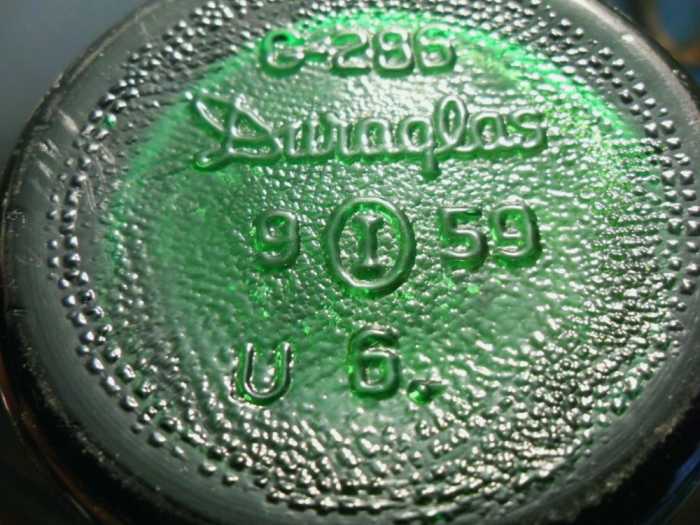
“O-I” trademark
The “O-I” mark (being the third major trademark embossed on the company’s glass containers) was officially registered by the United States Patent & Trademark Office on March 20, 2007, under registration #3219434. “First use” of this mark is claimed to have been on December 17, 1997, according to information posted on the justia.com website, here:
https://trademarks.justia.com/785/97/o-78597477.html
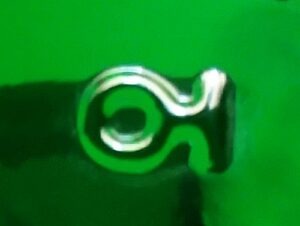
This trademark is in current use on most Owens-Illinois glass containers made within the United States (as of 2025).
“OWENS” appears on the base of some clear prescription bottles. Illustrated among the pics on this page is the base of a bottle made at the Columbus, Ohio facility (plant #18) with a date code of “7” which in this case probably stands for 1937. I don’t know how late the word “OWENS” was embossed as a trademark on the base of those medicine bottles.
ADVERTISEMENT
LIQUOR BOTTLE PERMIT NUMBERS
IMPORTANT NOTE: Many liquor bottles and flasks made by Owens-Illinois have a DIFFERENT mold code configuration on the base, as compared to the way the numbers are arranged on most other types of bottles they made. Typically, the bottle is marked with a number known as a “Liquor Bottle Permit Number” followed by a dash and a second number which is the date code – indicating the year the bottle was made. Many liquor bottles made by Owens-Illinois have the “Diamond and Oval with an I” logo embossed sideways on the base of the container.
For a list of liquor bottle permit numbers assigned to many glass companies in the United States after 1935, please check out this page I recently added to my site:
Liquor Bottle Permit Numbers – Numerical List.
NOTE: In July of 2013 I received a photo, submitted by Taylor McBurney, showing the base of a Yacht Club Beverages ACL soda bottle, carrying a 1966 date code, but bearing the old logo! This is the very latest instance of use of the “old” O-I mark that I am aware of. Presumably, when this particular mold was pulled out of the storeroom, and used to produce some more bottles (probably for a relatively small order), it wasn’t considered important enough to take the time to re-engrave the trademark. Update: (posted October 1, 2019) – also check out the base photo of a possible 1978 bottle, shown farther down on this page. There is also a photo of a bottle base (submitted by Crystal Arant) that appears to be from 1968 or 1969!
Other marks include ILLINOIS, a brand name apparently used for a line of prescription bottles (similar to their bottles marked “OWENS”); DURAGLAS, a trademark used after 1940 which is embossed on innumerable bottles of many types; and LOWEX, another brand name which was used for their borosilicate glass formula employed especially for power line insulators. For more information on the brand name Duraglas, you might want to check out my page here:
Duraglas trademark on bottles.
Although Owens-Illinois has made containers of many different shades of color over the years, the great majority of glass bottles commonly found (especially older containers that show up often at flea markets, antique malls, yard sales, junk shops, ebay, etc) are found in clear (colorless), green (emerald, forest green or “seven up” green) and amber (“beer bottle brown”) glass.
The “Diamond & oval with I” mark is by far the most common identification mark on glass containers found in trash dump sites in the United States from the 1930s, 1940s, and 1950s. (The second most common mark encountered is probably the “Large H over small A” used by Hazel-Atlas Glass Company.)
Electrical Insulators
Owens-Illinois took over operation of the Hemingray Glass Company factory, located in Muncie, Indiana, in 1933. Hemingray was a prolific maker of electrical insulators (of many types and sizes) for power lines, telegraph, telephone and other uses. Within a year or two, most glass insulators produced at Muncie were carrying date codes. Owens-Illinois continued to have the great majority of insulators marked with the “HEMINGRAY” brand name, with very few exceptions in later years. Other brand names used by O-I on insulators include Lowex and Kimble. Many millions of insulators were made at Muncie, the very last being manufactured in the year 1967. (Please see my webpage on the Hemingray Glass Company for more information on Hemingray insulators.)
ADVERTISEMENT
Owens-Illinois Inc. currently [2020] operates 20 glass manufacturing facilities within North America. They are located in: Atlanta, Georgia; Auburn, New York; Brockway, Pennsylvania [2 plants]; Ringgold, Virginia; Lapel, Indiana; Los Angeles, California; Muskogee, Oklahoma; Kalama, Washington (plant acquired in 2015, formerly Bennu Glass); Oakland, California; Portland, Oregon; Streator, Illinois; Toano, Virginia; Tracy, California; Waco, Texas; Zanesville, Ohio; Lexington, North Carolina; Windsor, Colorado; and in Canada: Montreal, Quebec and Brampton, Ontario.
For more detailed discussion on Owens-Illinois Glass Company and their date codes, and a detailed, updated chart of O-I plant location codes, please check out this comprehensive article written by Bill Lockhart and Russ Hoenig: The Bewildering Array of Owens-Illinois Glass Co. Logos and Codes.
Click here for a page from O-I’s official website:
https://www.o-i.com/our-story/how-glass-bottles-and-jars-are-made/
Note: For a webpage on this site with an extensive list of glass companies that made electrical insulators (which are now considered collectible items), please check out this page: Glass Insulator Manufacturers .
Click here to go to the alphabetical listings of trademarks found on bottles, jars, insulators and tableware: Glass Bottle Marks (starting here with Page One).
Please click here to go to my website Home Page.
Please check out my summary page on Sea Glass / Beach Glass. Many older Owens-Illinois bottle and jar bases might be found among so-called “Beach Glass”.


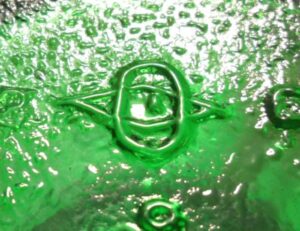




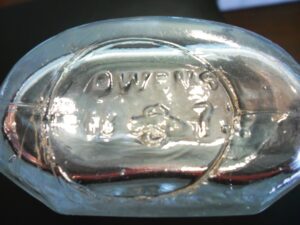


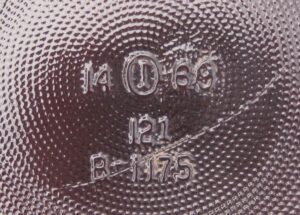
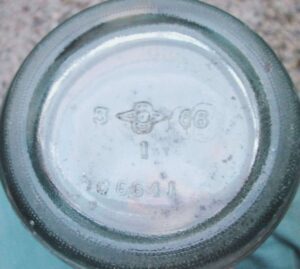
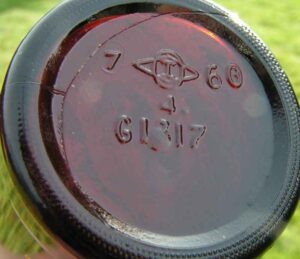
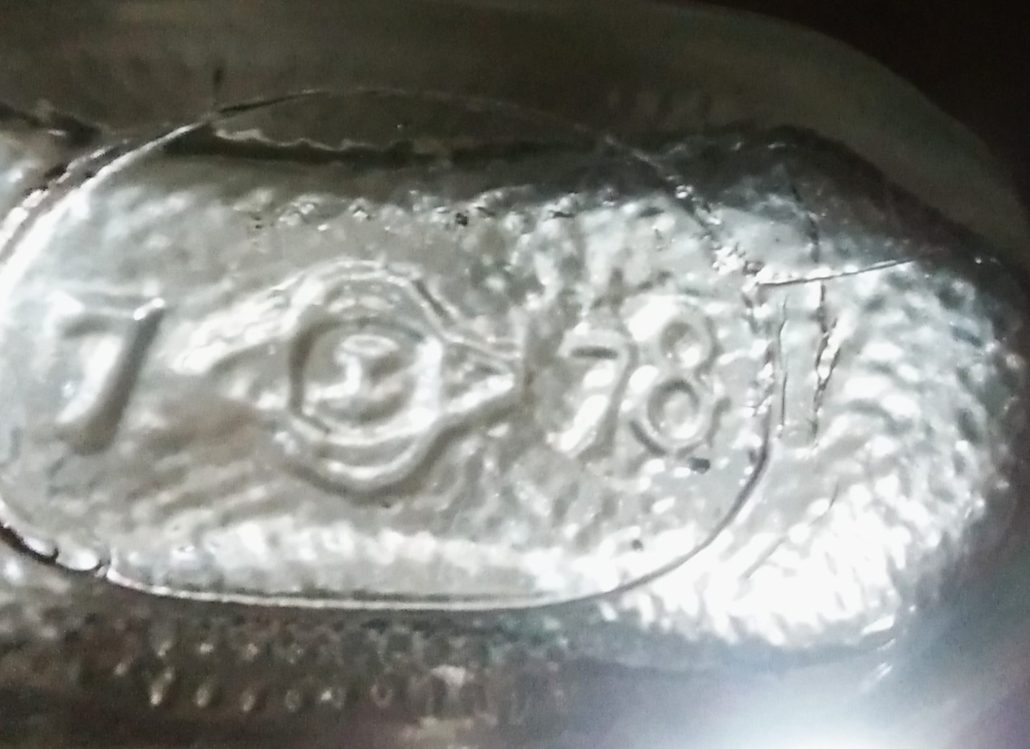

Here are a couple other webpages on my site that might be of interest, as I included a few pics of Owens-Illinois bottles and bases on them:
“Federal Law Forbids Sale or Reuse of the Bottle” marking on liquor bottles.
Numbers seen on the bases of Glass Bottles and jars.
ADVERTISEMENT


Hello my name is Sarah Shipp. I live in South East OK, I found a amber glass bottle with a cork top. It has the Owen Illinois symbol a diamond, an “O” and an “I” in the middle of the “O” the top of the “I” appears to be slightly “v” shaped.
Left of symbol is a 7, and right of symbol is a 3. Underneath it has 1845 and underneath the 1845 it’s 126.
Also on the side of the bottle it shows a “9.”
Thanks looking forward to hearing back from you.
Hi Sarah,
You have found one of the cylindrical “chemical” or “packer” style utility bottles that were used for a wide range of products – including medicines, cleaning products, liquid chemicals, fertilizers, etc. They were made by Owens-Illinois Glass Company in a number of different sizes, and usually are found in amber glass. Owens-Illinois used the catalog number or inventory number “1845” to identify that particular style (shape, profile) of bottle. They were made over a number of years. Your particular bottle was made at Alton, Illinois (plant location number 7) in either 1933 or 1943. (The “3” is a date code). I can’t guarantee which year is correct but 1933 is more likely. You can probably find similar bottles by searching ebay or Worthpoint archives with keywords such as “amber glass bottle 1845” (without the quotes). I hope this helps!
Thanks for writing,
David
Hello my name is Corey McCullough. I live in South East KY, I found a green 64oz glass bottle with a seven up twist on cap there’s no label left but, there is a lip pronounced all the way around the top and the numbers on the bottom are, beginning at the top going down, then from left to right, then bottom : the second OI without the diamond at the top, A7 on the left below that, 77 on the right of that, and 23 on the bottom can you tell me anything about this. Please my email is [email hidden] looking forward to hearing from you. Thank you.
Hi Corey,
I sent you an email several days ago but got no reply. I wanted to see pics of your bottle before answering, although I believe you have a soda bottle made in 1977. (I’m sorry this site isn’t set up correctly to allow readers to upload photos). Thank you and best regards,
~David
I have a 5 gallon glass bottle with the I inside the O stamp as well as what looks like a 9 below that and a 60 to the right hand side. So I’m guessing it’s a bottle from the Streator plant made in 1960.
Thanks
Hi Greg,
If the “9” is BELOW the logo, that would be a mold number and not a factory location code. There should be a number to the LEFT of the logo, and that would be the factory location code. However, on those large 5-gallon water bottles, oftentimes the numbers are there but hard to make out, especially if the base has a “network of crisscrossed lines” type of design covering the surface of the glass. But yes it sounds like your bottle was indeed made in 1960!
Thanks for your post!
David
Found a brown jar/bottle with the 4 io 0 and 11. Below with the number 500 under that. Any thoughts? Thanks!
Hi Tom, I sent a direct email to you but have not heard back. Please check your Junk/ Spam folders in case it was directed there by accident.
I wanted to see photos of that bottle. Unfortunately my site isn’t configured correctly to allow readers to upload photos directly to the Comments section. Thank you!
David
Found a bottle by a lake in eastern SD. Half pint
DI
55-41
Sam, sounds like you found a World War II era bottle. I presume it is also marked “Federal Law forbids sale or reuse of this bottle”. The “D-1” is a distiller identification code number. The “55-41” indicates it was manufactured at Owens-Illinois’ Huntington, WV plant. (Huntington’s official liquor bottle permit number was 55). The “41” is a date code for 1941.
Thanks for the post,
Best regards,
David
I came across a jar out in a field today with this mark. The plant code, date code, and mold number were all 7! Lucky me!
Thanks Lance!
I thought that was neat, and added your pic to the Owens Illinois article.
~David
Have a clear shard, side panel only LI. heel Reg 610617, bottom 56 owens symbol date code 41 bottom # R-514 on top of all this is a mean looking dog mouth open with teeth, curious thanks
Hi Kevin,
You have a piece of a Gordon’s Dry Gin bottle. The weird animal with teeth is supposed to be a wild boar (their trademark), although sometimes you have to use your imagination to see it! The “56” is a liquor bottle permit number that shows the bottle was made at the Owens-Illinois Glass Company factory at Charleston, West Virginia, yes, in the year 1941.
Hope this helps,
David
Thanks so much great info
Hi David I found a glass bottle on the beach today with marking on the bottom. It’s a 9 then an I with a circle around it then a 6 and under that the number 2
Hi Kev,
The dating on that bottle can be tricky but I’m assuming the “6” is a date code for 1956. It’s possible it’s for 1966. The “9” does tell us the bottle was made at their Streator, Illinois factory. The “2” is a mold number.
~David
Hello! I found a Four Roses whisky half pint on the beach. There is still remnants of the gold label on the front with black script and a State of California seal. On the bottom of the bottle is the diamond/oval stamp (no i) with 56 on the left of the D/O and 6 on the right, but no period. Would I be correct in assuming that this bottle is from 1940, by using your list of the liquor permit numbers?
Hello Rachel,
The “6” to the right of the Diamond/oval trademark is a date code. That date code stands for either 1936 (most likely) or 1946. The bottle was not made in 1940. I am sorry but there has been some misunderstanding about the permit number list because of the years I have listed (in parentheses) immediately to the right of each permit number. For readers, here is the page being referred to: https://glassbottlemarks.com/glass-industry-liquor-bottle-permit-numbers-numerical-list/
The years in parentheses don’t represent the beginning or ending dates of a company, or the year any particular bottle was made, but merely indicate that the glass company was included in a list of permit numbers that was published or updated that year. So the permit number was likely used for many years before and/or after the year given in parentheses. Sorry for any confusion. I explain this in the text, but it is easily missed by readers. Thanks for writing, and I hope this helps! Take care,
David
Hi David!
Bottle found today deep in the ground of my 1905 home. Aquamarine wide mouth external thread bottle with three indented panels on each side. Bottom is a hexagon shape with 3 markings (left to right) 8, square with an O, and 8. Measures 6.5″ tall, 6.5″ diameter and 2.5″ across hexagon bottle. Any help identifying appreciated as I cannot find anything like it with my own research. Bottle is in amazing condition!
https://imgur.com/a/9kvfjSI
https://imgur.com/a/Q8oreg4
Hi Lisa,
Thanks for including the links to photos of the bottle! That is a bottle style most closely associated with horseradish. Although horseradish was packaged in many different shaped bottles over the years, that is one of the more common shapes used, especially in the 1890s and through the early 1900s. The earlier types have a lip made for a cork closure, and later ones have a “screw threaded” top.
The general “look” of the bottle is also somewhat similar to some bottles used for pickled products, olives, and in some cases, honey. But I am sure that example almost certainly originally contained a brand of horseradish. Of course, the original label is long gone. I did find a similar bottle (probably not exactly the same, but a similar style) in the Worthopedia site auction listings archives. The link is here: https://www.worthpoint.com/worthopedia/antique-bottle-paper-label-kims-3848940177
Your bottle was made by Owens Bottle Company (O in a square was their trademark) and it would date from sometime in the 1919 to 1929 time period. The numbers are mold numbers and/or date codes, but I’m not 100% sure about their exact meaning. Hope this helps a bit!
David
Thank you David! I can’t see the price on worthpoint due to membership requirement. Can you see what it says? Just curious- no cracks or chips on mine! Lived in clay rocky soil for this whole time!
Hi Lisa,
I am not a member of Worthopedia and use it just for basic information, that is, text and photos included on old ebay auctions listings. So I can’t see the value either. The “market value” is merely the ending price of the item, and that sales price may or may not give us solid information on “real worth” to collectors. And yes, aqua bottles usually have a little bit more value than clear, but it depends on what bottle is being discussed. In general, aqua bottles tend to be older than clear (with tons of exceptions). My site is not really geared toward values, and more about the history of glass, so I can’t give you a definite value. But, in general those bottles are considered pretty common (to longtime collectors). But the value assigned to that bottle with the original label would be considerably higher than a bottle with no label.
On most older bottles, when the original label is still intact that usually adds value to antique bottles (because labels equals more information, more background, more provenance, more interest as far as colorful contemporary graphics, etc.) to the collector. If I were you I would perhaps try doing “saved searches” with keywords on ebay, over a period of time, and you might find similar listings and see what they actually sell for.
Hope this helps,
David
Thanks again David – you lead me to find it’s match however this Etsy listing does not share markings and its identical – based on my markings – seems like it was produced in 1928 (not 1930’s). See link! https://www.etsy.com/listing/529601085/1930s-mrs-barnes-binghamton-ny?ref=share_v4_lx
Hi Lisa,
Thanks for the link. I didn’t understand how you got the 1928 date. I didn’t see any base photos on that listing, but maybe I missed them? Without seeing the base code markings, it could theoretically be earlier or later (depending on what glass company made it, and if there is glassmaker mark and/or date code on the bottle).
Thanks! David
Hi David! I have what I believe is a 1939 fluted owens-illinois bottle, but I can’t seem to figure out what it was used for, I was wondering if there was a chance you or anyone else could take a look at it and find out what it was.
https://ibb.co/nRgN0DV (Full Bottle, has 12 sides)
https://ibb.co/1vKM5YW (Has a 5 on the side of the bottle)
https://ibb.co/ynPfcjW (Possible mold number that looks like it says “E788”)
https://ibb.co/djCRNk1 (Bottom of bottle, with a 2 and a 9)
Hi Tyler,
That actually looks like a weird combination of a soda bottle and a ketchup or pepper sauce bottle! To be honest I’m not sure what it held. The ‘crown top” is typical of soda bottles, but the fluted sides are more common on ketchup bottles. I suspect it could have been for an obscure brand of pepper sauce or maybe some other type of condiment. And yes I believe you are right that the “9’ is a date code for 1939. The “E788” would be the catalog number assigned to that particular bottle mold. Thanks and sorry I don’t have better information. Maybe an antique bottle collector / digger will land on this page and identify it for us!
David
I found a one-gallon bottle at a garage sale with the “earliest” trademark on it, and was interested in seeing if I could get a date for it. It has a 2 to the left of the diamond and a 6 to the right, with an 11 underneath it. It has Des.Pat. 96235 embossed below the trademark. The bottle has a basket weave pattern embossed on it. Thanks.
Hello Dawn,
With your information, I found the design patent on the web with a google search. Here is a link to the page with diagram and text of the patent issued for that bottle design: US Design Patent Number 96235S
The design was patented July 16, 1935. (87 years ago tomorrow!) The patent was in effect for 14 years, so, theoretically, bottles of that design could have been made anytime from 1935 to 1949. Your particular bottle was manufactured in 1936 (the “6” to the right of the logo is a date code for 1936). It was made at the Huntington, West Virginia plant, and the “11” is a mold number. Hope this helps!
David
I found a Duraglas bottle with the cap on the shores of Lake Michigan in southwest Michigan.
It has the following markings:
23- circle around the triangle and I’m guessing a one (but looks like a dot)-2
3-H
Duraglas
1735-EP
Can you please decode this for me?
Thanks
Jose
Hi Jose,
Duraglas was introduced in 1940, so we know your bottle was made after that year. The “23” is a manufacturing plant code number for their Los Angeles, CA location. (I assume you meant “diamond” not triangle). If you meant there was a number “2” directly to the right of the logo, that is a date code, and probably stands for either 1942 or 1952. Don’t know what “3-H” indicates. “1735-EP’ is probably a code number for that particular bottle style. Hope this helps a bit!
David
Good afternoon I was hoping you could help me identify a jar I found, It’s a regular mouth quart canning jar and on the front is the word Mason under that a star then under the star the word Jar. The bottom of the Jar has the (left to right) number 7 circle with an “I” inside then the numbers 75. next line is just the number 2.
Hi Jessi,
That sounds like one of their regular line of modern canning/fruit jars. From the markings you describe, I would say the jar was made at Alton, Illinois (their main plant, indicated by the number 7) in 1975. The “2” is a mold number. Hope this helps!
David
Is there a way to determine what brand of whiskey was in this bottle?
amber whiskey bottle
front: 4/5 QUART
off center on base: Owens Illinois I in oval, diamond
Codes on base:
56
R125
5
Although 56 is not listed in the permit code document you have shared, I read in several of your responses that it was OI’s permit number for their Charleston, WV facility.
I understand R125 to be a rectifier number, but it is not listed in the web document you shared in response to another reader’s comment.
I assume the 5 is a mold number.
Maybe I am off base, or maybe there is nothing else that can be determined. Thanks for any thoughts you have.
Hi Bill,
With the original label missing, I don’t know of a surefire way of finding out what was originally contained in the bottle. From the markings you describe, your bottle sounds like a generic or “standard” type of “fifth” liquor bottle made by Owens-Illinois. I believe the “5” is a date code for 1935. And, assuming that the company (rectifier) that was assigned the number R125 distributed/produced/sold a number of different brands or types of liquor, I presume they would (or could) have used the same style of bottle for several different products, and, as per their routine, they merely applied different labels onto those bottles to reflect the contents.
I might also note that fairly recently (after I had posted comments, over several years, about the #56 liquor bottle permit number) , with help from some other researchers, I’ve posted a more complete list of the permit numbers here on this webpage: https://glassbottlemarks.com/glass-industry-liquor-bottle-permit-numbers-numerical-list/
So, to sum up, no, I doubt if you will be able to discover exactly what beverage was in your bottle.
Thanks for writing, and I hope this helps a little!
David